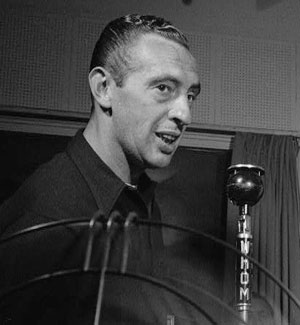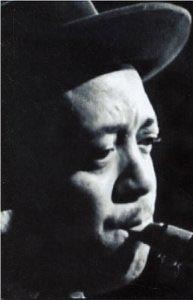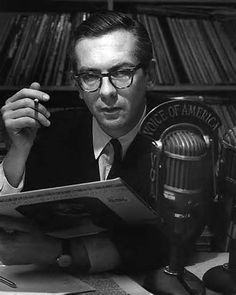 from Russia and his mother from Romania. Sid grew up in a poor area of Brooklyn where he discovered jazz as a teenager and although he attempted the trumpet at one point, he never became a musician.
from Russia and his mother from Romania. Sid grew up in a poor area of Brooklyn where he discovered jazz as a teenager and although he attempted the trumpet at one point, he never became a musician. [A computer might ask you to allow the music to play on this page]
Jumpin' WithSymphony Sid |
Jumpin' with my boy Sid in the city,
Mr. President of the DeeJay committee,
We're gonna be up all night gettin' with it
We want you to spin the sounds by the minute
From down in the land that's really a-pretty
If you haven't heard Lester Young's composition, you can listen to it here.
Symphony Sid was Disc Jockey Sid Torin. He was born Sidney Tarnopol in New York City's Lower East Side in 1909 - his father was  from Russia and his mother from Romania. Sid grew up in a poor area of Brooklyn where he discovered jazz as a teenager and although he attempted the trumpet at one point, he never became a musician.
from Russia and his mother from Romania. Sid grew up in a poor area of Brooklyn where he discovered jazz as a teenager and although he attempted the trumpet at one point, he never became a musician.
The source of his nickname has a number of suggested origins. Some say that during the Depression he worked in the Symphony record shop where his customers told how they bought their records from 'Symphony Sid'.
In 1937, he began an afternoon record show at WBNX in the Bronx, and some say he was given his name there when he played classical recordings. 'Symphony Sid was "the accepted white voice of the New York black" music scene, said Arnold Passman, author of The Deejays. Torin built up a Harlem audience by playing what were then known as "race records." Listeners responded by patronizing the 125th Street shops Sid advertised.'
Symphony Sid
In another story, the name might have come from a sponsor - a men's clothing store,  and when announcer Walter Tolmes opened Sid's show, he rhymed "Here comes the kid with the fancy pants and the fancy lid... Symphony Sid.", but it is possible, of course, that this came after the name was established. In one obituary it was written: 'But it was his masterful salesmanship as well as his musical taste that won Torin commercial success. Consider his distinctive style: "If you got eyes to be the sharpest, take a tip from Old Daddy Sid and fall by Al's Pants Shop, for the pants with the peg bottom and the wide knee."
and when announcer Walter Tolmes opened Sid's show, he rhymed "Here comes the kid with the fancy pants and the fancy lid... Symphony Sid.", but it is possible, of course, that this came after the name was established. In one obituary it was written: 'But it was his masterful salesmanship as well as his musical taste that won Torin commercial success. Consider his distinctive style: "If you got eyes to be the sharpest, take a tip from Old Daddy Sid and fall by Al's Pants Shop, for the pants with the peg bottom and the wide knee."
Lester Young
Whatever the truth is, he became famous for playing the biggest hits of black performers such as Count Basie and Duke Ellington, and as one of the few DJs who played black music regularly, he became very popular with young people. By 1941, Sid was presenting a late-night show in New Jersey where he featured new up-and-coming black musicians including Dizzy Gillespie and Charlie Parker, and in time he moved on to present radio shows at WWRL, WMCA and WJZ in New York.
Here is a wonderful video from 1958 of Lester Young with an amazing role call of musicians jumpin' - amongst them: Charlie Shavers (trumpet); J C Higginbotham (trombone); Coleman Hawkins, Lester Young (tenor saxes); Pee Wee Russell (clarinet); Harry Sheppard (vibraphone); Willie "The Lion" Smith (piano); Dickie Thompson (guitar); Vinnie Burke (acoustic double bass) and Sonny Greer (drums).
A number of musicians wrote music dedicated to the hip - talking DJ in gratitude for his support: Walkin' With Sid by Arnett Cobb and Symphony In Sid by Illinois Jacquet are two more. Pres's Jumpin' With Symphony Sid eventually had lyrics added by King Pleasure:.
Comments by those who remember him appear on various YouTube pages:
'I didn't much listen to Symphony Sid but two of my neighbor kids in my Washington Heights building were his kids by his mistress, Lady Stewart: George and Patty. Sid did the right thing and paid the rent on the apartment as well as provided for the kids ... I only discovered this fact much late in life when my father mentioned it in the 1990's.'
'Staggered into high school class bleary-eyed from listening to Symphony Sid sixty years ago. Those were the days.... '
'I used to fall asleep listening to Sid.'
In his novel On The Road, Jack Kerouac wrote: 'Dean took the wheel and drove clear the rest of the way to New York, and we began to hear the Symphony Sid show on the radio with all the latest bop, and now we were entering the great and final city of America.'
Let everything go real crazy over JZ
Make everything go real crazy over JZ
Let everything cool for me and my baby
I don't wanna think we're listenin' to Lacey
It's gotta be Prez, Bird, Shearing, or the Basie
And now it's all set real clear close to eighty
Let it roll
The 'JZ' in the lyrics refers to the station WJZ. Sid left WMCA in early June 1949, but later that month he received his biggest opportunity, a network program on what was then called WJZ (later known as WABC) - he was heard in more than 30 states. As a result of his jazz network show featuring the music of artists like Miles Davis and Charlie Parker, he gained wider exposure with a national audience. As time went on, critics would refer to him as "the dean of jazz radio".
Apparently, "Lacey" (rather than 'lazy' as shown in some lyrics) refers toanother popular DJ, Jack Lacey, a rival broadcaster whose show was called "Listen to Lacey" and who played Standards (thus: 'Hey Sid, don't play pop tunes and make us think we're listening to Lacey!'). "80" most likely refers either to WJZ, broadcasting at 770 (close to 800), or possibly the call letters of another one of Sid's NY stations, "WADO radio, 1280 on your dial".
In 1981, Joe Jackson paid homage to Lester Young and Symphony Sid with this fast, rocking version of the tune on his album Joe Jackson's Jumpin Jive:
The album was a collection of covers of classic 1940's swing and jump blues songs originally performed by musicians such as Louis Jordan and Cab Calloway. The personnel on the album were: Joe Jackson (vocals and vibraphone), Dave Bitelli (tenor saxophone and clarinet), Graham Maby (bass), Raul Olivera (trumpet), Pete Thomas (alto saxophone), Larry Tolfree (drums) and Nick Weldon (piano). Multi instrumentalist Jackson is best known for his 1979 hit pop single Is She Really Going Out With Him? before he moved on to  more jazz influenced music, moved from England to New York and then ended up in Berlin where he still lives. Pianist, composer and poet Nick Weldon's song Lavender's Blue has been recorded by jazz singers Claire Martin and Christine Tobin, amongst others.
more jazz influenced music, moved from England to New York and then ended up in Berlin where he still lives. Pianist, composer and poet Nick Weldon's song Lavender's Blue has been recorded by jazz singers Claire Martin and Christine Tobin, amongst others.
Sid was white, but he was famous for his hipster talk and his knowledge of the black music scene. Some critics later accused white jazz disc jockeys like Sid and Alan Freed of profiting from black radio and taking jobs away from black announcers, but this did not seem to be a concern during the years when Sid broadcast. In fact he won several awards from black organisations, including an award for Disc Jockey of the Year presented to him in 1949 by the Global News Syndicate, for his "continuous promotion of negro artists".
According to Wikipedia, it seems to have been 'an open secret that Sid was a regular user of marijuana. While the slang expression was "reefer", a home where marijuana was used and sold was known as "tea pad", and the police raided Sid's apartment in the summer of 1948, and arrested him. He remained on the air while the case was pending, and it finally came to trial in late January 1949. The case was declared a mistrial, but there was some residual damage to Sid's reputation. Some sources say he was fired from WJZ, while others indicate he continued to work as an MC in the clubs. But he evidently decided it was time for a change of scenery, and went with his friend Norman Furman to Boston in about 1952 where he hosted a gospel show and a jazz show. But Sid had a unique arrangement with Furman - he worked at WBMS in the daytime, and at night, he worked for WCOP, where he did live jazz shows, just like he had done in New York.
By 1957, Sid had left Boston and returned to New York, this time working on WEVD AM & FM. Sid's show featured Latin music (salsa), for which, as Steely Dan's Donald Fagen recalled in a letter to Countermoon Zine, he was dubbed by some the "Jazz Traitor". 'Then in the late 70s, encouraged by his engineer, Marty Wilson, Sid again started to play jazz in the last hour of his show. When he retired, he gave Wilson his record collection and the jazz show continued on the weekends.'
Here is a conversation between Symphony Sid and Ralfie Pagan in 1972 at the time of Sid's last broadcast introduced by Tito Puente's Latin version of Jumpin' With Symphony Sid. Some critics found his Latin music show both interesting and important, and praised the concept as "an extraordinary meeting of cultures".
Sid retired to Florida in the 1970s and died in 1984 of emphysema and heart disease. Many have credited him with being the person who introduced jazz to a wide audience, and Leslie Gourse in the New York Times said: 'He is probably the greatest middleman jazz has ever known. A broadcaster for 35 years, once billed as "the all-night, all-frantic one", he was the man to listen to in the forties, fifties and sixties if you wanted to know what was happening in jazz.'
We close with this video of Jumpin' With Symphony Sid from the Cannes Jazz Festival in 1958 with some superb solos from Bill Coleman (trumpet), Don Byas (tenor sax), Claude Bolling (piano), Arvell Shaw (bass) and J.C. Heard (drums):
More Tracks Unwrapped:
© Sandy Brown Jazz 2016